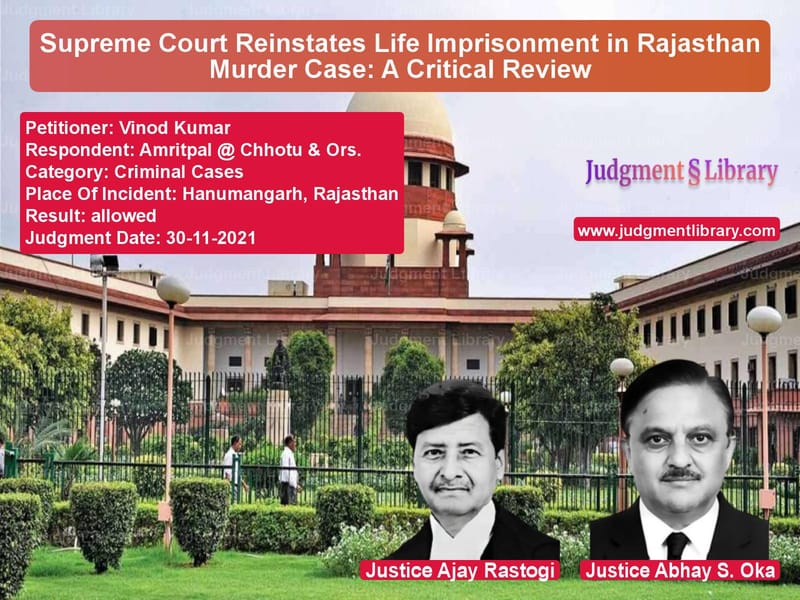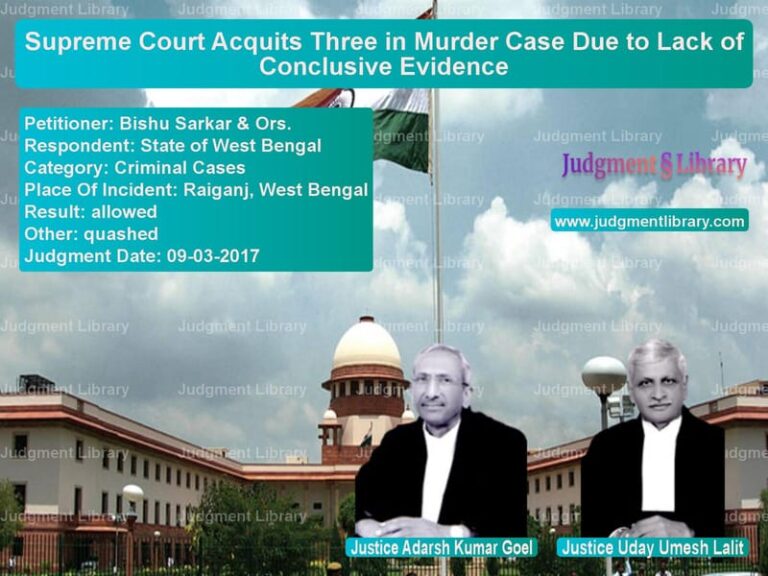Supreme Court Reinstates Life Imprisonment in Rajasthan Murder Case: A Critical Review
The Supreme Court of India recently delivered a crucial judgment in the case of Vinod Kumar v. Amritpal @ Chhotu & Ors., reinstating the conviction of the accused for murder under Section 302/149 of the Indian Penal Code (IPC). The case highlights the legal distinction between murder and culpable homicide, emphasizing the importance of judicial scrutiny in determining the intent and gravity of criminal acts.
The Sessions Court had initially convicted the accused under Sections 147, 364, 302/149, 201, and 323/149 IPC, sentencing them to life imprisonment along with fines. However, the Rajasthan High Court modified the conviction to Section 304 Part II IPC, reducing their sentence to eight years’ rigorous imprisonment. The Supreme Court, upon appeal, overturned the High Court’s decision and restored the Sessions Court’s ruling, underscoring the necessity of interpreting legal provisions in their correct spirit.
Factual Background of the Case
The case stems from a brutal incident involving the abduction and murder of Balveer Singh. On October 5, 2005, the victim, Balveer Singh, along with Vijay Singh (PW1), was returning from Hanumangarh when they were intercepted by the accused. The accused forcibly took them in a Tata Sumo vehicle, assaulted them, and later inflicted grievous injuries upon Balveer Singh, ultimately leading to his death.
Read also: https://judgmentlibrary.com/supreme-court-dismisses-review-petition-in-criminal-case-no-error-found/
According to the testimony of Vijay Singh (PW1), the accused first assaulted Balveer Singh in an open field before taking him to a doctor, suggesting a lack of premeditated intent to kill. However, later actions of the accused, including smashing the deceased’s face and throwing his body into a canal, pointed towards a deliberate attempt to conceal their crime. The prosecution presented strong medical evidence that demonstrated the injuries inflicted on the deceased were of a nature sufficient to cause death.
Sessions Court’s Judgment
The Additional District and Sessions Judge, Fast Track Court No. 1, Hanumangarh, Rajasthan, found the accused guilty under Section 302/149 IPC and sentenced them to life imprisonment. The court relied heavily on:
- Eyewitness testimony of Vijay Singh (PW1)
- Medical reports confirming fatal injuries on the victim’s vital organs
- The accused’s actions post-crime, particularly their attempt to mutilate the deceased’s face to avoid identification
The Sessions Court concluded that the accused acted in furtherance of a common intention to kill, thus attracting the liability of Section 149 IPC, which deals with unlawful assembly.
High Court’s Reversal
On appeal, the Rajasthan High Court upheld the conviction under Sections 147, 364, 201, and 329/149 IPC but modified the conviction under Section 302 IPC to Section 304 Part II IPC, reducing the sentence to eight years’ rigorous imprisonment. The High Court reasoned that:
- The injuries, though grievous, were not necessarily intended to cause death
- The accused had taken the victim to a doctor, which indicated an absence of intent to kill
- The murder did not meet the threshold under Section 300 IPC
This judgment was challenged by the appellant, Vinod Kumar, the deceased’s brother, who argued that the High Court erred in concluding that the injuries were not inflicted with murderous intent.
Supreme Court’s Rationale for Overruling the High Court
The Supreme Court extensively analyzed the case, particularly in light of precedent set in Virsa Singh v. The State of Punjab. The Court noted that:
- The injuries inflicted were on vital organs, including fractured ribs and a ruptured lung, causing excessive bleeding and death
- The accused deliberately smashed the deceased’s face before dumping the body, indicating a clear attempt to cover up their actions
- The application of “thirdly” under Section 300 IPC was appropriate since the injuries were sufficient in the ordinary course of nature to cause death
Justice Abhay S. Oka, delivering the judgment, remarked:
“Once the prosecution establishes the existence of the three ingredients forming a part of ‘thirdly’ in Section 300, it is irrelevant whether there was an intention on the part of the accused to cause death.”
Legal Principles Reinforced by the Judgment
The Supreme Court’s ruling reaffirmed several important legal principles:
- Difference between Murder and Culpable Homicide: The distinction between Sections 299 and 300 IPC is critical in determining the degree of criminal liability.
- Application of ‘Thirdly’ in Section 300 IPC: If an injury inflicted is sufficient to cause death in the ordinary course of nature, it qualifies as murder.
- Liability under Section 149 IPC: If an unlawful assembly shares a common object to commit a crime, all members are equally liable.
Conclusion
The Supreme Court’s decision serves as a crucial precedent in ensuring that courts do not erroneously downgrade serious offenses. By reinstating the life imprisonment sentence, the judgment upholds the principle that severe crimes must be met with commensurate punishment. The ruling also reinforces the need for meticulous legal scrutiny in distinguishing between murder and culpable homicide.
The accused were directed to surrender within six weeks, failing which legal measures, including arrests, would be initiated. This case highlights the Supreme Court’s role as the ultimate interpreter of criminal law, ensuring that justice prevails over procedural lapses or misinterpretations at lower courts.
Petitioner Name: Vinod Kumar.Respondent Name: Amritpal @ Chhotu & Ors..Judgment By: Justice Ajay Rastogi, Justice Abhay S. Oka.Place Of Incident: Hanumangarh, Rajasthan.Judgment Date: 30-11-2021.
Don’t miss out on the full details! Download the complete judgment in PDF format below and gain valuable insights instantly!
Download Judgment: vinod-kumar-vs-amritpal-@-chhotu-&-supreme-court-of-india-judgment-dated-30-11-2021.pdf
Directly Download Judgment: Directly download this Judgment
See all petitions in Murder Cases
See all petitions in Bail and Anticipatory Bail
See all petitions in Judgment by Ajay Rastogi
See all petitions in Judgment by Abhay S. Oka
See all petitions in allowed
See all petitions in supreme court of India judgments November 2021
See all petitions in 2021 judgments
See all posts in Criminal Cases Category
See all allowed petitions in Criminal Cases Category
See all Dismissed petitions in Criminal Cases Category
See all partially allowed petitions in Criminal Cases Category







